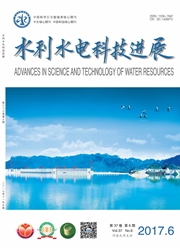

 中文摘要:
中文摘要:
以低弗劳德数、大单宽流量的安谷水电站为例,对不同方式形成多级水跃的消力池进行了系列水工模型试验,研究了不同方案形成的多级水跃的水力学特性。试验结果表明:采用多排消力墩方式形成多级消力池,其消能率虽有保证,但消力墩布置形式对池内流态影响较大,对不同单宽流量工况适应性不好,特别是单宽流量大时难以形成多级水跃;采用圆弧进口连续坎式消力池大幅度改善了流态,但仍未能形成两级水跃;采用跌坎进口连续坎式形式的两级浅水垫消力池,在很大流量范围内均形成明显的两级水跃流态,消能效果理想,池内临底流速和出池流速均比其他方案低,结合下游的反坡护坦,间接抬高了下游水位,使得出池水流平顺,且结构简单,施工方便。
 英文摘要:
英文摘要:
In this study, the characteristics of hydraulic jumps in three types of multiple stilling basins were experimentally investigated, taking the Angu hydropower project as an example. The experimental results indicate that: when a multiple stilling basin formed by baffle blocks is used, although its energy dissipation ratio is satisfactory, the multiple hydraulic jumps cannot be formed with a large unit width discharge; although the flow pattern can be greatly improved when an abrupt drop and a continuous bucket at the beginning and middle of the basin were adopted to replace the conjunction and the baffle blocks respectively, the double hydraulic jumps still cannot be formed; and two apparent and favorable hydraulic jumps can be formed within a large discharge range in a new multiple stilling basin with two shallow cushions. The velocities near the bottom and the outlet velocities with the new basin were found to be smaller than those with other types of the multiple stilling basins. Combined with the downstream reverse sloping apron, the new basin can raise the downstream water level and smooth the flow pattern. The structure of the new basin is simple and can be easily constructed.
 同期刊论文项目
同期刊论文项目
 同项目期刊论文
同项目期刊论文
 期刊信息
期刊信息
